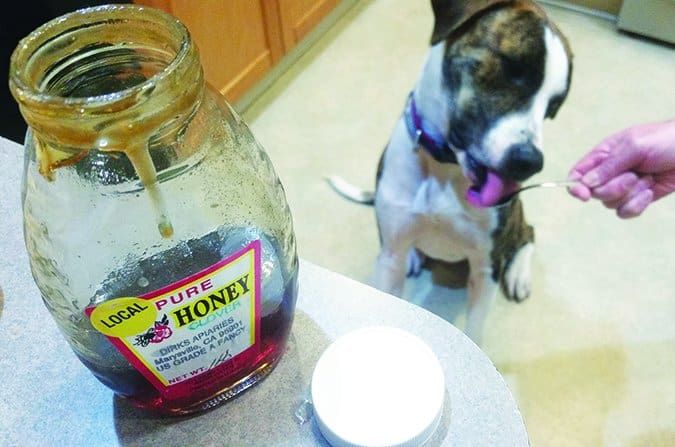Honey is an amazing gift from nature, used for more than a thousand years to promote health and recover from illnesses. It’s loaded with beneficial vitamins and minerals, as well as powerful antioxidants. It has research-proven antibacterial/antimicrobial properties, can calm allergic reactions, and will soothe irritated skin and throats.
Look for “raw” honey, preferably from local beekeepers, rather than the processed product often found on grocery-store shelves. Raw honey is strained to remove debris, but that’s it. It’s otherwise as natural as you can get. Shop at the farmer’s market or do an Internet search for local beekeepers.
Processed honey, on the other hand, is manufactured with heat, which thins it and destroys many of its beneficial attributes. In fact, many processed honey products aren’t even truly honey, as the manufacturing can filter out the beneficial pollen.
Natural honey color will vary from light to dark golden amber, depending on the flowers the bees used to make the product. It’s only a color.
While larger doses are safe, dogs don’t need much honey in order to benefit from its ingestion. A quarter-teaspoon per 20 pounds of body weight daily is enough for health maintenance.
Since dogs enjoy honey’s sweet taste, it’s easy to feed from a spoon or, if the honey is thick, you can roll it into a treat-sized ball. Honey can be fed by itself, mixed with powdered herbs for additional benefit, or added to herbal teas that double as cough syrups. To find instructions on creating your own herbal honey, see “Herbal Medicine for Your Dog,” (April 2007). We’ve read that some people add honey to the dog’s water. If you do that, you should offer plain, fresh water as well.
Dogs benefit from raw honey in the following ways:
1. Raw honey provides allergy relief to dogs.
Medical research supports the use of local honey to combat environmental allergies. Note that we said local honey. A local product contains tiny amounts of the pollen in your area, so that when your dog ingests the honey, his body can adjust to the potential allergens gradually, which should help prevent a full-blown attack. Hint: Be sure you’re dealing with an environmental allergic reaction. Itching, scratching, and hot spots can also indicate a food allergy. See “Suspect Your Itchy Dog Has a Food Allergy?” (March 2015).
You can even take things a step further in your quest for allergy relief. Texas beekeeper and dog trainer Michele Crouse washes her dogs with it. “I start with a clear, natural shampoo base from an organic supplier,” she says, “and mix it with an equal amount of honey to which I’ve added aloe vera and essential oils like lemongrass, orange, lemon, lavender, tea tree, citronella, and the Asian herb May Chang (Litsea cubeba). All of these plants have disinfecting, deodorizing, or insect-repelling properties. The essential oils make up about five percent of the formula, so it’s safe for adult dogs and older puppies. To dilute the shampoo and make it easier to use, I add about 25 percent water.”
The resulting shampoo doesn’t lather much, Crouse says, but it cleans the dog well and soothes the skin. “I let it stand for a minute or so, rinse it off, reapply, and then give a final rinse. I board dogs, and if a visiting dog is scratching and itching, I’ll give him a bath in honey shampoo, and that always helps.”
2. Raw honey soothes symptoms of kennel cough.
Honey is a time-honored solution for soothing irritated throats and coughs. For kennel cough, you can use local honey, but Manuka honey may be your best choice. Made by bees pollinating the Manuka trees in New Zealand and parts of Australia, Manuka honey has the highest antibacterial properties of any honey in the world. It’s also the highest-priced honey in the world, and may cost three or four times what you might pay for local honey.
3. Raw honey helps heal dogs’ burns, scrapes, and cuts.
Manuka honey is also a top choice for a natural wound dressing. In fact, Manuka honey is FDA-approved for use on human burn patients. But any raw honey will help keep the wound area clean and moist, which promotes healing. Honey’s natural antibacterial properties reduce the chance of infection and protect the injured area.
After cleaning the wound, spread on a thick coat of honey and then apply a light bandage, if necessary. Of course, you may have to also use an Elizabethan collar or similar device to stop your dog from licking the area!
Note: Deep, wide or puncture wounds should always be examined by a veterinarian before applying any medicine.
4. Raw honey reduces gastrointestinal upset in dogs.
For minor bouts of an upset stomach or diarrhea that might come from something simple, such as your dog feasting on fresh grass, a couple of doses of honey may help quiet and soothe his GI tract.
Some veterinarians suggest honey to help control minor stomach ulcers, since honey’s natural antibacterial properties can help destroy bacteria that may be causing the ulcer.
Again, you need to be certain about what you’re dealing with, so seeking veterinary advice in these situations is wise.
5. Honey lends an energy boost to dogs.
Honey is a sugar, and sugar boosts energy. Anecdotal evidence shows that honey helps many older dogs regain some of their former spunk and drive. Many owners of canine athletes use honey to promote energy, endurance and vitality.
Tips for Feeding Your Dog Honey
All honey is thick, but honey that has crystallized is usually too thick to pour or even scoop out. It can be softened by putting the jar in a bowl of hot tap water. The water should reach about three-quarters of the way up the jar. Let it sit for five to 10 minutes, stirring occasionally after the first five minutes. This method will soften the product without harming it because you’re not using too much heat. Do not use a microwave or put the honey in boiling water on a stove top. Store honey at room temperature in a tightly sealed jar.
Potential Problems with Feeding Honey to Your Dog
Honey contains 64 calories in a tablespoon. While that may not seem like much, it’s a relative thing, depending on your dog’s normal weight and his activity level. Unwanted weight gain can result from the addition of a daily dose of honey, if other adjustments are not made (i.e., reducing other treats or the amount of food your dog receives).
Heads up: If your dog is diabetic, discuss the use of honey in his diet with your veterinarian. Honey is a simple sugar.
A final caution: Do not give honey to puppies. Natural, raw honey can contain very small numbers of Clostridium botulinum spores, which can be found in dirt and dust. The mature digestive systems of adult dogs (and humans) can move the spores through the body before they cause any harm, but puppies (and babies) can become sick from ingesting the spores. Save honey treatments for dogs who are more than a year old.
Here are some more reasons to use caution when administering honey. Ultimately, however, raw honey is safe and beneficial to adult dogs.
For an in-depth survey of all the ways you can use honey and other bee products for dogs, read “Bee Products Have a Special Meaning for Dogs,” (September 2007).
Cynthia Foley is an experienced freelance writer and dog agility competitor in upstate New York. Her last piece for Whole Dog Journal was “Reduce Your Dog’s Cancer Risks” in August 2016.







I used eat a spoonful of raw, local honey every day to combat my seasonal allergies – and it worked! But I had horrible stomach cramps to the point of fasting, only eating rice for days – and not feeling any better. I was at a loss as to what was making me sick for months. I thought I had a never ending flu or serious health issues. But I was still taking my daily dose of honey. I looked it up, and apparently the gut had trouble digesting the high amount of fructose in honey. I also noticed I can no longer tolerate any syrups, such as natural maple syrup. Could it be the same case for some dogs? Just wanted to post a warning for owners to be aware.
I give my 42lbs 16 month old active dog, a generous tea spoon of raw honey mixed with two table spoons of Greek yogurt , he enjoys it very much after a good romp in the park.